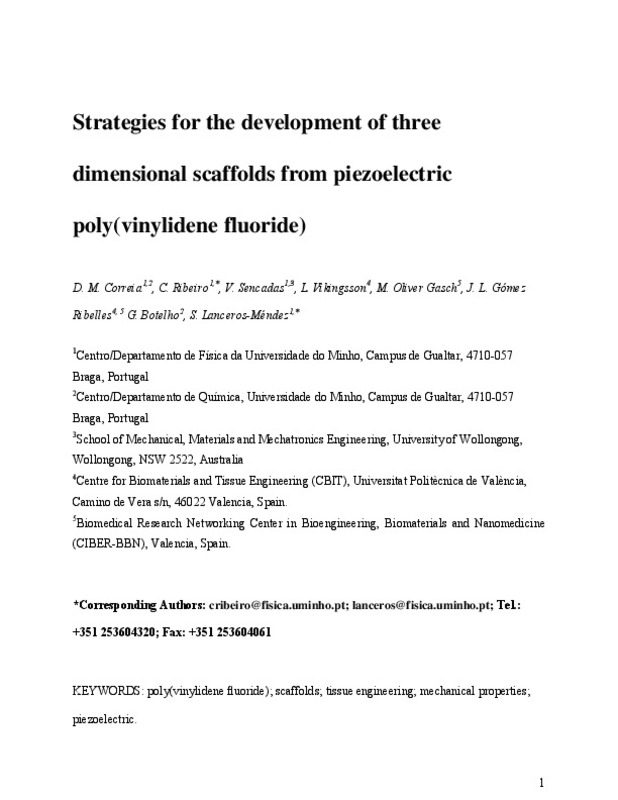Correia, D.; Ribeiro, C.; Sencadas, V.; Vikingsson, L.; Gasch, MO.; Gómez Ribelles, JL.; Botelho, G.... (2016). Strategies for the development of three dimensional scaffolds from piezoelectric poly(vinylidene fluoride). Materials and Design. 92:674-681. https://doi.org/10.1016/j.matdes.2015.12.043
Por favor, use este identificador para citar o enlazar este ítem: http://hdl.handle.net/10251/80993
|
Título:
|
Strategies for the development of three dimensional scaffolds from piezoelectric poly(vinylidene fluoride)
|
|
Autor:
|
Correia , Daniela
Ribeiro, Clarisse
Sencadas, V.
Vikingsson, Line
Gasch, M. Oliver

 Gómez Ribelles, José Luís
Botelho, G.
Lanceros-Mendez, Senentxu
Gómez Ribelles, José Luís
Botelho, G.
Lanceros-Mendez, Senentxu
|
|
Entidad UPV:
|
Universitat Politècnica de València. Escuela Técnica Superior de Ingenieros Industriales - Escola Tècnica Superior d'Enginyers Industrials
Universitat Politècnica de València. Centro de Biomateriales e Ingeniería Tisular - Centre de Biomaterials i Enginyeria Tissular
|
|
Fecha difusión:
|
|
|
Resumen:
|
Cell supports based on electroactive materials, that generate electrical signal variations as a response to mechanical deformations and vice-versa, are gaining increasing attention for tissue engineering applications. In ...[+]
Cell supports based on electroactive materials, that generate electrical signal variations as a response to mechanical deformations and vice-versa, are gaining increasing attention for tissue engineering applications. In particular, poly(vinylidene fluoride), PVDF, has been proven to be suitable for these applications in the form of films and two-dimensional membranes. In this work, several strategies have been implemented in order to develop PVDF three-dimensional scaffolds. Three processing methods, including solvent casting with particulate leaching and three-dimensional nylon, and freeze extraction with poly(vinyl alcohol) templates are presented in order to obtain three-dimensional scaffolds with different architectures and interconnected porosity. Further, it is shown that the scaffolds are in the electroactive beta-phase and show a crystallinity degree of similar to 45%. Finally, quasi-static mechanical measurements showed that an increase of the porous size within the scaffold leads to a tensile strengths and the Young's modulus decrease, allowing tuning scaffold properties for specific tissues.
[-]
|
|
Palabras clave:
|
Poly(vinylidene fluoride)
,
Scaffolds
,
Tissue engineering
,
Mechanical properties
,
Piezoelectric
|
|
Derechos de uso:
|
Reserva de todos los derechos
|
|
Fuente:
|
Materials and Design. (issn:
0261-3069
) (eissn:
1873-4197
)
|
|
DOI:
|
10.1016/j.matdes.2015.12.043
|
|
Editorial:
|
Elsevier
|
|
Versión del editor:
|
http://dx.doi.org/10.1016/j.matdes.2015.12.043
|
|
Código del Proyecto:
|
info:eu-repo/grantAgreement/FCT/5876-PPCDTI/109368/PT/“Smart joint implants using bionanocomposites-(SIMBIO)”/
...[+]
info:eu-repo/grantAgreement/FCT/5876-PPCDTI/109368/PT/“Smart joint implants using bionanocomposites-(SIMBIO)”/
info:eu-repo/grantAgreement/FCT//PEST-C/FIS/UI607/2014/
info:eu-repo/grantAgreement/FCT//SFRH/BD/82411/2011/
info:eu-repo/grantAgreement/FCT/SFRH/SFRH/BD/82411/2011/PT/
info:eu-repo/grantAgreement/FCT// SFRH/BPD/90870/2012/
info:eu-repo/grantAgreement/FCT/SFRH/SFRH/BPD/90870/2012/PT/
info:eu-repo/grantAgreement/MINECO//MAT2013-46467-C4-1-R/ES/ESTIMULACION MECANICA LOCAL DE CELULAS MESENQUIMALES DE CARA A SU DIFERENCIACION OSTEOGENICA Y CONDROGENICA EN MEDICINA REGENERATIVA/
[-]
|
|
Agradecimientos:
|
This work is funded by FEDER funds through the "Programa Operacional Fatores de Competitividade - COMPETE" and by national funds arranged by FCT Fundacao para a Ciencia e a Tecnologia, project reference PEST-C/FIS/U1607/2014. ...[+]
This work is funded by FEDER funds through the "Programa Operacional Fatores de Competitividade - COMPETE" and by national funds arranged by FCT Fundacao para a Ciencia e a Tecnologia, project reference PEST-C/FIS/U1607/2014. The authors also thank support from the COST Action MP1301 "New Generation Biomimetic and Customized Implants for Bone Engineering". DMC and CR, thank the FCT for the SFRH/BD/82411/2011 and SFRH/BPD/90870/2012 grants, respectively. JLGR acknowledges the support of Ministerio de Economia y Competitividad, MINECO, through the MAT2013-46467-C4-1-R project CIBER-BBN is an initiative funded by the VI National R&D&i Plan 2008-2011, Iniciativa Ingenio 2010, Consolider Program, CIBER Actions and financed by the Instituto de Salud Carlos III with assistance from the European Regional Development Fund.
[-]
|
|
Tipo:
|
Artículo
|






![[Cerrado]](/themes/UPV/images/candado.png)



